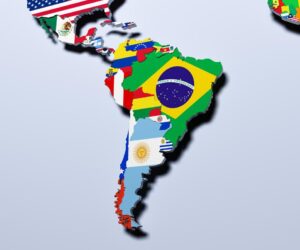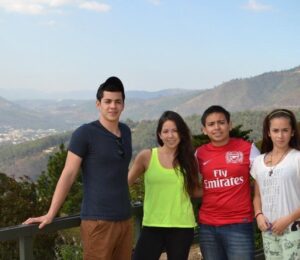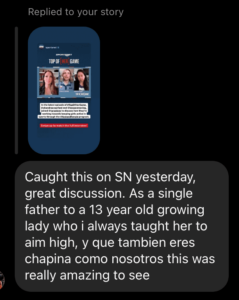In this 26th edition, we learn more about Kaitlyn’s experience attending the 2024 WNBA All-Star…

Celebrating Latin American Heritage Month in Canada with the Estrada’s
Our very own Gabriela (Gaby) and Alejandra Estrada share more on what Latin American Heritage Month in Canada is and it’s significance to them and their family. Please note that this is just the perspective of Gaby and Alejandra and in no way represents what this month means to all those of Latin American Heritage.
October was proclaimed Latin American Heritage Month in Canada in 2018 by the Parliament of Canada; the month was deemed a time to recognize the Latin American community’s “tremendous contribution to Canadian Society,” (Canadian Heritage, 2021). But what does this mean? And who and what exactly is the Latin American Community?

The Latin American Community: Latin America is composed of 21 countries or territories: it starts in North America with Mexico and goes down to the furthest point of South America in Argentina and Chile. Latin America includes countries in the Caribbean. All 21 countries or territories are: Mexico, Guatemala, Honduras, El Salvador, Nicaragua, Costa Rica, Panama, Colombia, Venezuela, Ecuador, Peru, Bolivia, Brazil, Paraguay, Chile, Argentina, Uruguay, Cuba, Haiti, the Dominican Republic and Puerto Rico (Wikipedia, 2022).
The populations and communities in Latin America often identify themselves as being Latinx/Latine/Latino/Latina – people that originate from a country in Latin America; the spelling of the word is very much an individual choice, as Latinx and Latine are terms “used to describe people of all genders who have Latin American roots, as well as people whose ancestors are from multiple Latin American Countries,” (Washington Post, 2022). Although these terms are used to unite peoples and communities from Latin America, it is very important to note that Latinx/Latine/Latino/Latina people are not a monolith and are not a race: we are made up of groups that have “different racial and ethnic backgrounds…[and also of people] who do not speak any Spanish [and instead] speak a variety of other languages, [like] Creole, Quecha, or Spanglish,” (Vice, 2020). Latinx/Latine/Latino/Latina people include Black, Indigenous, White, and multi-racial people. We are a diverse group with both many similarities and many differences, which is part of what makes our cultures so rich and beautiful. It is also important to note that Latin America has a deep rooted and ongoing history of racism and anti-Blackness within their own communities towards Black people and Indigenous people. As a collective, our people and culture need to do better.

What is this month and what it means to us: Latin American Heritage Month is meant to be a month to celebrate Latin American origin and people’s in Canada and how we “enrich [Canadian fabric] with [our] diverse and vibrant cultures, cuisine, music, dance and more,” (Canadian Heritage, 2021). For us, Gaby and Alejandra, and our family, this is something we strive to do this month and everyday. Our parents immigrated here from Guatemala back in the early 80’s and the two of us, alongside our brother Marvin Jr., were all born here in Scarborough (Toronto, ON). Latin American culture and, in particular, traditions from Guatemala were infused and continue to be infused into our entire being. Some things are more minor, like Guatemalan and Spanish slang, whereas others are big yearly traditions during key holidays. Being proud to celebrate our parent’s heritage and culture also includes things like listening to our music, eating our delicious food (I mean, have you tried frijoles with fresh queso and warm tortilla?!), speaking the language (or finding ways to relearn it, in Alejandra and Marvin Jr.’s case), and connecting and reconnecting with family.

Ultimately, for us, celebrating Latin American Heritage is about celebrating our dad. It’s about making our dad proud of the sacrifices he made, alongside our other family members, in choosing to leave home and come to a new country to create better opportunities for us. It’s reflecting on the barriers and hardships our family experienced and continue to experience in immigrating to this country, learning a different language, and finding ways to assimilate into Canadian culture while still being true and authentic to themselves and bringing whatever they could from back home into their day to day lives through language, music, food, art and other aspects of culture. And then it’s us looking for ways how to incorporate Guatemala culture into who we are and reminding ourselves how proud we are of our family, our heritage, our culture and being able to be extensions of that. To be role models for each other, for others from Latin America, and to make our dad and family proud to be Latinx.

For me, Gaby, receiving this DM after being on Tara Slone’s Top of Her Game on Sportsnet was that reminder of how important it is to have that representation and to be a proud, vocal Latina and celebrate our Latin American heritage and culture all day, everyday! Translation: “And that you too are Chapina [slang for someone from Guatemala – Chapin/Chapina/Chapino] like us…”.
Here are ways that you can celebrate Latin American Heritage Month in Canada this month (and every month):
- Learn more about the history of Latin America by reading books, blog posts, and watching movies on and by Latinx/Latine people.
- Support Latin American businesses by shopping at their stores and visiting their restaurants (our favorite restaurants in Scarborough are El Pulgarcito and Mexitaco!)
- Learn more about ways you can play an active role to reduce cultural barriers and uncover your unconscious bias towards the Latin American community by taking a course and educating yourself.
- If you yourself are Latinx/Latine, learn more about the racism and anti-Blackness within our communities towards the Black community and Indigenous community and what actions you can take to be actively anti-racist.
For more ways on how you can celebrate this month, check out this blog post by Good Good Good and this one by Forbes!



